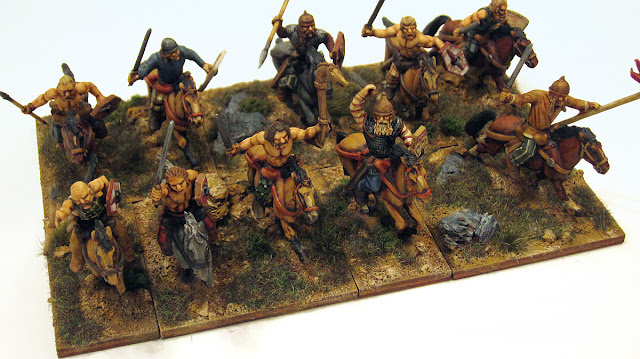Wargames Factory's Romans were one of the first historical miniatures plastic kits to hit the market. Although their tooling is fairly basic compared to some of the really fine sets that are being released currently, they are still an affordable way of building up a Roman army quickly. Until Warlord Games and Victrix release their early and late Republican Roman sets, Wargames Factory's seems to be the cheapest method of getting mail armored legionnaires on the table.
I've built a few boxes over the last year, and found
Scott McPhee's tips invaluable before starting on my own. I won't reiterate his great advice, but I've posted a few items of my own I think I can offer after the jump.
Wargames Factory Shields Tips
I confess. Despite the great visual impact shields make once finished, I find making them rather tedious. Here's the system I employed to get them done as quickly as possible.
The plastic shields in the kit weigh very little. To keep them from being blown around by spray primer, and save time by not taping or affixing them to putty I simply snipped one of the sprue supports and then bent the shield up on the remaining sprue support. Attached to the frame, the shields didn't blow around when primed, and by tilting them up I was able to spray the upper shield rim where the first support was trimmed off. Once dry, I snipped them off the remaining support, and trimmed the rim. That unprimed rim would become the bottom of the shield, where the naked plastic wouldn't be seen.
For the decals I used a combination of knife and scissors. I started by making straight incisions to remove the decal and backing from the central portion of the decal through which the shield boss needs to protrude.
Finally I cut each decal out with a pair of tiny scissors that came in a fingernail care kit. Their tiny size and slightly curved blades made trimming the decals out a snap.
Finally I affixed each decal to a shield, taking care that the weathered portion of the shield was on the same side as the unprimed lower rim.
Building Wargames Factory Romans Tips
Scott McPhee described the challenges he had getting these legionnaires to rank up. I wanted to avoid similar issues, so I took care during assembly to make sure they'd be able to form ranks easily. The arms holding weapons (pilum or swords) will encroach into the space of of other ranks, but I didn't have any problems getting an offending pila or elbow to squeeze into the area between two figures in another rank. The worst offender is the shield held in the offhand, which can't easily be squeezed between the figures of another rank. To ensure the figures can rank up, I made sure to rotate the offhand as low as possible. By keeping the shield hand close to the figure's waist, the shield takes up as little space in front of the figure as possible.
 |
| The figures don't hold the shield out in front of them, but keep it low, nearly touching the base. |
Keeping the shield low also allows the "cocked back" sword arm able to position the blade just above the rim of the shield, ready to deliver a blow to an enemy's face. Much better than having the blade pointed at the back of the shield.
 |
| Wargames Factory Romans rank up if shield arms are rotated properly. |
During assembly I was sure make a few adjustments to the body of each figure as well. Each arm socket received a few crosshatch incisions from my hobby knife to give a little more surface area for the glue to latch on to. Also, I made sure that any figure that was armed with a sword had the hilt in his scabbard snipped off, since that sword is being held by the same figure.
And that's it! I enjoyed building these figures, and despite the shallow detail on some of the bits even with a table standard paint job I think they look nice once ranked up and based.






















